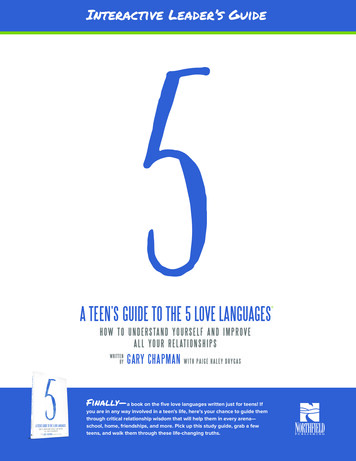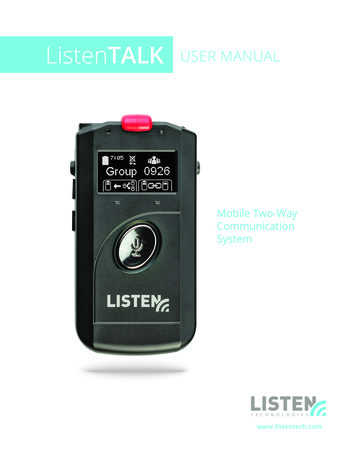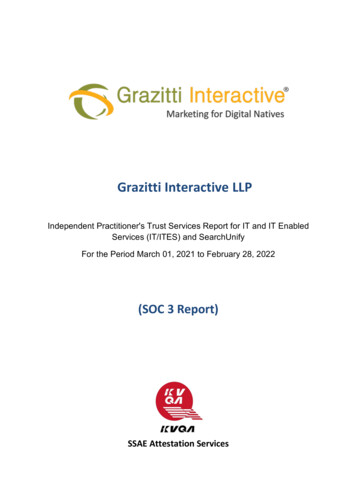
Transcription
Interactive Leader’s GuideFinally—a book on the five love languages written just for teens! Ifyou are in any way involved in a teen’s life, here’s your chance to guide themthrough critical relationship wisdom that will help them in every arena—school, home, friendships, and more. Pick up this study guide, grab a fewteens, and walk them through these life-changing truths.
Table of ContentsContentsFacilitator Instructions 2Lesson One: WO R DS 4Lesson Two: T I M E 8Lesson Three: G I F T S 13Lesson Four: S E RV IC E 17Lesson Five: T O U C H 21Lesson Six: R E V IE W 25
Facilitator InstructionsFacilitatorInstructionsThank you for being a discussion facilitator for A Teen’s Guide to the5 Love Languages. Whether you are a youth leader, teacher, parent, coach,or other, your presence in the lives of teens is important. Your wisdom willgreatly help them as they grapple with these critical relationship principles.Before you begin, here are a few notes to keep in mind.E L E M E N T S O F S U CC E S S F U L D ISC U S S I O N G RO U P L E AD E RS H I PBe prepared. We encourage facilitators to be as familiar with the discussion guide as possible. You should at the veryleast read through the lesson before you lead it. Try completing each lesson’s activities on your own so that you cananticipate any hurdles you may need to help the teens over. It would also be helpful if you review the correspondingchapter in A Teen’s Guide to the 5 Love Languages.Be open. These discussion groups thrive on vulnerability. Your appropriate openness will set the tone in your groupfor the teens to be open. If you notice that certain teens are hesitant to participate, direct some of the lower-demandquestions their way so that they can get more comfortable sharing.Be consistent. If the teens are not reading the material, discussion will lag. Please put on your teacher hat at the endof each lesson and remind the teens to read for the next meeting. If you notice that certain teens are consistentlynot reading the material, you may ask them to join a discussion group at a time when they are willing to prioritize thereading. This same principle applies to attendance.Be timely. As you well know, teens have shorter attention spans than adults do. Try to limit your discussion lengthto no longer than an hour. The various parts of each lesson will break things up so that the lesson flies by, but still,be conscious of attention spans. Especially beware of letting the review section take too long. We recommend thatsection take a maximum of fifteen minutes.Be selective. While we don’t want to exclude teens, we recognize that the benefits of small groups are lost whenthere are more than a dozen people involved. If you have too many teens for one group, great! If you have time, leada second group at a different time. Or better yet, seek out another dependable adult and encourage him or her tofacilitate a group.
Facilitator InstructionsE L E M E N T S O F L E AD I N G A L E S S O NEach lesson consists of six parts, plus brief notes to the leader at the beginning and end of each lesson:Note to the Leader. This is a reminder about the week’s topic, and an encouraging word for getting started.Six parts of each study:1. Warm Up (5 minutes). The purpose of this activity is to get the discussion off on an engaging foot, ratherthan jumping right into reviewing the chapter. Think of it as an activity that introduces the chapter’s lovelanguage while also providing a “hook” to spark interest and engagement. At the end of this section,hand out the activity sheets. These are provided as a printable PDF, titled “Teen’s Guide ActivitySheets,” at 5lovelanguages.com (on the resource page). Your copies are in this guide with each lesson.2. Review (15 minutes). Here is an opportunity to get everyone on the same page—literally. It is briefdiscussion around the book’s content, and it will go best if everyone has the book in front of themfor reference. If the prompt doesn’t seem to draw out or sustain good discussion, you may use thePause & Process prompts at the end of each chapter. Think of these more like discussion starters; theyare meant to get the conversation going initially or jump-start it if it stalls. More important than gettingthrough the questions is listening intently to the teens’ responses, restating their answers in your ownwords to show you’ve heard and understood them, and then asking thought-provoking follow-upquestions. You may also ask the group to respond to one another’s comments.3. Engage (10 minutes). This section transitions the lesson toward application. The goal is to have thestudents begin recognizing this love language at work (or neglected) in everyday life. Discussion promptsfor this section are provided.4. Read (10 minutes). This section carries the conversation forward by providing supplementary content orillustrations that elucidate the love language. Discussion prompts for this section are provided as well.5. Apply (10 minutes). This is a brief section where the teens receive specific advice for how to speak thelove language throughout the next week.6. Role Play (10 minutes). This section helps teens get a jump start on the Apply section. It is anopportunity to practice or visualize the love language. Ask the teens to volunteer to read the variousparts, and encourage them to get into character! Then briefly discuss the interactions---what did youobserve, how can we apply it to our lives, and so on.Before You Go. This is a reminder to offer a one- or two-sentence takeaway about the lesson, and to remindstudents to read the chapter for the next session. You may also mention any important details about the logisticsof your next meeting. Say whatever will help your group come prepared for the next time you meet. An example ofwhat to say is provided in the first two lessons.
Interactive Leader’s Guide chapter 1Love Language #1 WO R DSN OT E T O L E AD E RThis week’s lesson is on words. Your group should have already read the chapter on this love language, so thefollowing exercises are meant to refresh their memory, solidify the content, and help them apply it. If you are nervousabout getting started, that’s totally normal! You might even open up your time together by acknowledging that smallgroups can be intimidating, but that we’ll all be feeling comfortable in no time, and that you appreciate everyone’swillingness to be involved. Leading off on a relational foot like that will set a great tone.WA R M U PTo help your group get in the zone, start by saying, “This week’s discussion is about words of affirmation,” andthen share an example of someone’s words of affirmation that meant something for you. For example, finda special written message, like a card or letter you keep tucked away in a special box somewhere. Read aloudthe parts you’re comfortable sharing. Explain the story behind it. Then ask your group to share like you just did.Your example and openness will encourage your teens to share their own similar special messages (and don’t besurprised if theirs is a saved email, text message, or voicemail).Before moving on to the next section, hand out the activity sheets.R E V IE WHave your group look at the Review activity. Help the teens list and explain the different uses or “dialects” ofWords of Affirmation: appreciation, encouragement, praise, and kindness (see book pages 26–29). Turn to thePause & Process section on page 33 for additional discussion starters.E N G AG EHave your group look at the Engage activity. Tell the teens that as much as we must learn to speak the languageof Words of Affirmation, we must also learn to receive love in this language. Have them look at the cartoon in theactivity, and then say, “Think of a situation in which someone might say this to you. How could you respond in a waythat validates their words instead of dismissing them?”R E ADHave your group look at the read activity. Read the story of Captain Scott’s last letter, and then guide discussion.Ask questions like: What was the purpose of Scott’s words?What do you think this letter meant to his widow?(To let teens know what the letter is worth to complete strangers, inform them that a similar letter recentlysold at an auction for 245,000!)5
Interactive Leader’s Guide chapter 1This is a very small excerpt of the letter. What else do you suppose he said?A P P LYHave your group look at the Apply activity. In this section, you want to help your teens understand theimportance of our words and give them simple ideas for how to use their words well. The suggestions herefocus on using words to express love in ways we normally might not—at an unexpected time, to an unsuspectingrecipient, or in an unconventional way. Encourage your group to try out one or more suggestions this week.RO L E - P L AYHave your group look at the Role-Play activity. This takes the above application one step further. Have your groupact out each version of the scene. After each one, discuss how words affect the mood and the feelings of thoseinvolved. Focus on the overall tone and statements like “You have to,” “I told you,” and “You never.” Talk about howour feelings change the tone—and thus the meaning—of our wordsB E F O R E YO U G OOffer a one- or two-sentence takeaway about the lesson, and remind your students to read the chapter for the nextsession. You may also mention any important details about the logistics of your meeting. Say whatever will helpyour group come prepared for next time. Here’s an example:“Thanks, everyone, for your participation today. I hope you can find ways to show love this week by using kind,encouraging, and affirming words, especially to those who need a lift. Don’t forget to read next week’s chapter,which is about the love language of quality time. We’re meeting at the same time and place next week, andDylan has offered to bring snacks.”6
Activity Sheet chapter 1Love Language #1 WO R DSReviewEngageUse Words of Affirmation to:Great Job!I’m reallyproud of you!ReadApplyIn March 1912, Captain Robert Scott lay huddled Write a thank-you note to someone whoin his tent in Antarctica, waiting out a storm. He hadprobably isn’t expecting one (e.g., someonelost his race to be first to the South Pole and nowwho didn’t just give you a present). Explainstruggled to return to his base camp. As he sufferedwhat that person has done that you appreciate.from starvation and frostbite, he penned a last letterTell how it has impacted you.to his wife and two-year-old son. Think of someone you care about but rarely“To my widow. We are in a very tight cornertalk to. Maybe it’s a grandparent, other relative,and I have doubts of pulling through. If anythingor an old friend. Call just to say “hi.” Spend ahappens to me, I should like you to know howfew unhurried minutes on the phone together.much you have meant to me. Oh my dear, whatdreams I had of [our son’s] future. What lots and Try out a new format for using your wordslots I could tell you of this journey. What tales youto show love! Write a poem or a song. Sendwould have for the boy, but, oh, what a price toa video greeting via email. Shoot out a textpay. To forfeit the sight of your dear, dear face.”or a snapchat.The letter was finally delivered after Scott’s body wasfound that November.7
Activity Sheet chapter 1Role playLov e L a n gua ge # 1 : WordsTAK E 1MOM is busy talking on the phone.ALEX:Mom!MOM keeps talking on the phone.ALEX:(more impatiently) Mom, come ON! I’m gonna be late!MOM:(into phone) Sorry, Lisa. I’ve got to go. (to ALEX) What’s the problem?ALEX:I told you! You have to drive me to practice, and now I’m going to be late!MOM:Honey, that was Casey’s mom on the phone. I was making sure Casey’s dad is picking you upon the way to practice. That’s probably them in the driveway right now.ALEX:You never tell me anything.TAK E 2MOM is busy talking on the phone.ALEX smiles and taps wrist as if wearing a watch.MOM keeps talking on the phone.ALEX smiles, raises eyebrows, and makes steering wheel gestures.MOM:(into phone) Sorry, Lisa. I’ve got to go. (to ALEX) What’s the problem?ALEX:Remember, I have practice. Actually, I think we were supposed to leave already.MOM:That was Casey’s mom on the phone. I was making sure Casey’s dad is picking you up on theway to practice. That’s probably them in the driveway right now.ALEX:Oh good. Thanks for making sure I have a ride. Love you, Mom!8
Interactive Leader’s Guide chapter 2Love Language #2 T I M EN OT E T O L E AD E RThis week’s lesson is on time. Before you begin, you may remind the group that last week you covered words. Trymentioning two or three highlights from your time together, specifically observations that students made. In that oneact, you will both illustrate words of affirmation and encourage an atmosphere of openness.WA R M U PTo help your group get in the zone, start by saying, “This week’s discussion is about quality time.” Acknowledgethat we all face the dilemma of how to spend our limited time well. Share with the teens a time-managementchart like this one:U RG E N CYI M P O RTAN C EImportant, UrgentNot Important, UrgentImportant, Not UrgentNot Important, Not UrgentAsk about where their daily activities fit, like homework, practice, rehearsal, personal time, and family time. Discussthat the way we spend our time reveals what is important to us.Before moving on to the next section, hand out the activity sheets.R E V IE WHave your group look at the Review activity. Help them understand the difference between quality and quantitywhen it comes to the language of time. Ask them to explain the difference, and lead them toward the right ideaif they aren’t quite getting it. Ask, “Is one always better than the other? Why or why not?” For additional discussionstarters, go to the Pause & Process section on page 46.E N G AG EHave the group look at the Engage activity. Explain that conversation is a two-way street. It involves focusingon the other person, active listening, and authentic contribution. Read through the obstacles listed in the activityand explain any if you need to. Discuss the question “How do these obstacles interfere with conversation?” Havethem complete the activity. Then discuss this question: “How are we guilty of doing what we claim to dislike when itcomes to quality conversation?”9
Interactive Leader’s Guide chapter 2R E ADHave the group look at the Read activity. Read the article about the effects of being left out. Discuss: Does this research align with your experience? How does knowing this information affect your behavior or beliefs? For example, would youexclude someone you don’t like from your lunch table? Would you physically attack that person?What’s the difference?A P P LYHave the group look at the Apply activity. Tell them that since this exercise is about expressing love, notreceiving it, they should think about what the other person would most enjoy. Add something like, “If it’s somethingyou don’t care for, that’s not the point. In fact, it will show your love even more if you spend time doing somethingyou’re not crazy about just to make the other person feel loved. You may even find you enjoy the activity becauseit’s important to someone you love.”RO L E - P L AYHave the group look at the Role-Play activity. Act out Take 1. How was Taylor not being a good listener? What’swrong with statements like “Don’t be mad,” “No offense, but ” and “I’m just saying”? What could Taylor have saidinstead? Act out the scene again, substituting more effective conversational techniques.B E F O R E YO U G OOffer a one- or two-sentence takeaway about the lesson, and remind your students to read the chapter for the nextsession. Mention any important details about the logistics of your next meeting. For example:“Thanks for another great discussion, everyone. I encourage you to make plans and follow through onshowing quality time and attention to someone you care about, in a way that speaks to them. Remember thatnext week we’re meeting an hour later because several of you have soccer practice. Sarah said her momplans to send her with four-layer chocolate bars for our snack. I don’t know what those are, but they don’tsound like something you’ll want to miss.”10
Activity Sheet chapter 2Love Language #2 T I M EReviewEngageQuality vs. Quantity:Think about quality conversation.How much does each obstacle bother you?Mark an X on the scale (10 being most bothersome).Texting/Using a Phone0510Interrupting the Speaker0510Multitasking (watching TV, cooking, etc.)0510510Focusing on Self0Now consider how guilty you are of each one.Mark it with an O.ReadApplyThe Effects of Being Left OutQuality activities may take some planning. Think aboutThe pain of rejection occurs in the same part of thethe people closest to you. How would they most enjoybrain as physical pain. Studies have shown that a mildpainkiller can reduce the pain of rejection, suggestingthat emotional pain is every bit as real as physical pain.spending time with you?PersonActivityIn addition, pain that comes from being excluded orrejected remains much more painful than physicalpain long after the event. After a physical injury, thevividness of the pain eventually wears off. However,the emotional pain of being excluded remains just asstrong when recalled years later.Emotional pain does not lessen when the event canbe explained away by reason, either. Even if theperson who was rejected understands that it was amisunderstanding or a ruse, the very real pain that wasinflicted remains.Now make plans to do it!11
Activity Sheet chapter 2Role playLov e La n gua ge # 2: Ti m eTAK E 1SAM:(angrily) I can’t believe it! No one works harder than I do in the sailing club, but David got theservice scholarship.TAYLOR:(sympathetically) Don’t be mad. There’s always next year.SAM:(still mad) Of course I’m going to be mad! David doesn’t even do anything! He only raised themost money because his dad sold a lot of stuff at his office.TAYLOR:No offense, but you probably could’ve raised more money if you’d started trying earlier.SAM:What’s that supposed to mean?TAYLOR:I’m just saying, you didn’t even start trying to do the fund-raiser until the final week.SAM:Never mind. You aren’t even listening to what I’m saying.TAK E 2SAM:(angrily) I can’t believe it! No one works harder than I do in the sailing club, but David got theservice scholarship.TAYLOR:SAM:(still mad) David doesn’t even do anything! He only raised the most money because his dad solda lot of stuff at his office.TAYLOR:12
Interactive Leader’s Guide chapter 3Love Language #3 G I F T SN OT E T O L E AD E RThis week’s lesson is on gifts. Before you begin, you may remind the group that last week you covered qualitytime. Try mentioning two or three of the good ideas students shared about ways they could spend quality time withothers. Ask if anyone has a quality-time story from the week.WA R M U PTo help your group get in the zone, start by saying, “This week’s discussion is about gifts.” Give an illustration fromyour own life about the role of gifts in relationships, but instead of focusing on a gift you’ve received, talk abouta special gift you have given. Was it handmade? Expensive? What made it so special? Allow teens to share similarstories. Discuss how gifts, even when chosen with the recipient in mind, reflect the giver.Before moving on to the next section, hand out the activity sheets.R E V IE WHave the group look at the Review activity. Ask, “What’s the difference between receiving something as a giftand buying it yourself? If the item is the same, what makes the two experiences different?” For more discussionstarters, see page 55.E N G AG EHave the group look at the Engage activity and ask them to complete it. Discuss what makes one gift morespecial than another. Ask, “Is it always personal preference (perhaps you just like scarves more than headphones)?Consider time, effort, thought, and price. Why doesn’t everyone have the same #1?”R E ADHave the group look at the Read activity. Ask a student to read the letter to Mr. Manners. Discuss your responsesto each point. You may check online for etiquette advice on the topic so that you can help the teens sort throughthe questions. Ask, “Why is it important to receive gifts graciously? How is it about the giver as much as thereceiver?”A P P LYHave the group look at the Apply activity. Ask them, “Who will you keep gift lists for? What can you add to theselists right away? Think about what you already know about those close to you.”13
Interactive Leader’s Guide chapter 3R E ADHave the group look at the Role-Play activity. Have the students act out each scenario, improvising a response toeach situation. Discuss: When things don’t go your way, is it more important to be honest or kind? If at a loss for words, focus on the gesture rather than the gift (e.g., “You must have spent a lot of time onthis”). How should you respond when the gift giver doesn’t seem to care (as in role-play situation #4)?A P P LYOffer a one- or two-sentence takeaway about the lesson, and remind your students to read the chapter for the nextsession. Mention any important details about the logistics of your next meeting.14
Activity Sheet chapter 3Love Language #3 G I F T SReviewEngageReceiving a gift vs. buying it yourselfRank the gifts below in order of how special they wouldbe to you (1 most special).Expensive headphonesA playlist of music for an upcomingroad tripA T-shirt that supports a cause you care aboutTickets to a game or show you likeA gift card to the mallA handmade scarf or hatA scrapbook of photos and souvenirsA photo of your favorite celebrity signedspecifically to youReadApplyDear Mr. Manners,Start paying attention! Keep a notebook or set up aPlease help. I never know how to act when I receivea gift. I’ve heard that you’re not supposed to open itnote on your phone. Add to it whenever you encountergift ideas for those close to you.in front of others, but I’ve also heard it’s okay to openit immediately.Should I tear it open or carefully remove the tape?Read the card aloud or silently?What happens if I don’t really like the gift? Do I have topretend I like it?Sometimes, when I receive many gifts at the same time,I’m afraid I might get a duplicate. How can I handle thatso no one feels bad?If I say thank you in person, do I still have to send athank-you note later?Signed,Beguiled by Gifts15
Activity Sheet chapter 3Role playLov e L a n gua ge # 3: Gi f tsS I T UAT I O N 1: You do not like the giftFRIEND:Happy Birthday! I hope you like it. I searched all over to find just the right one.YOU:(after unwrapping a hideous sweater)S I T UAT I O N 2: The gift is a duplicateGRANDMA:Now, I know you’ll love this because your dad said it was number one on your list!YOU:(after unwrapping something you already have)S I T UAT I O N 3: The Gift is HandmadeSISTER:I’m not really good at sewing yet, but I saw this fabric and thought of you right away.YOU:(after unwrapping a poorly sewn tote bag)S I T UAT I O N 4: The gift is thoughtlessSECRET BUDDY: Here ya go.YOU:(after unwrapping an obviously regifted, unappealing book)S I T UAT I O N 5: The gift is AwesomeUNCLE:I saw this and thought you might enjoy it.YOU:(after unwrapping a great gift you didn’t even ask for)16
Interactive Leader’s Guide chapter 4Love Language #4 S E RV IC EN OT E T O L E AD E RThis week’s lesson is on service. Before you begin, you may remind the group that last week you covered gifts. Trymentioning two or three of the good gift ideas students shared. Ask if anyone gave or received a meaningful giftthis last week.WA R M U PTo help your group get in the zone, start by saying, “This week’s discussion is about service.” Brainstorm thedifferent ways we use the word service in society (customer service, military service, food service, etc.). Discusseach one. “Is it an example of the love language of service? Why or why not? Can something still be consideredservice if it is paid for or expected?”Before moving on to the next section, hand out the activity sheets.R E V IE WHave the group look at the Review activity. Explain how each of these body parts is important in serving theother parts: hands, heart, and brain. What if one of these elements is missing? Discuss the possible results(or examples) of serving with only hands and heart, only hands and brain, and only heart and brain. For morediscussion starters, see page 66.E N G AG EHave the group look at the Engage activity. Ask, “What characteristics of martyrdom make it different fromservice?” (Potential answers: a wrong attitude, self-centeredness, expectation of recognition, and so on.)R E ADHave the group look at the Read activity, and ask one to read it. Chapter 5 refers to an example of service fromthe Bible. Regardless of your religious beliefs, you can read and discuss this story as an example of the languageof service. According to this story, what is Jesus’ position in relation to the disciples? To Judas? If there was no household servant available, how might these people have chosen who should washthe others’ feet? How is leading by example more effective than just telling others what to do?17
Interactive Leader’s Guide chapter 4A P P LYHave the group look at the Apply activity. Discuss: How can you practice the language of service? Brainstorm clubs, organizations, or just individual acts of service in each category. What causes are near toyour heart? How can you serve? Ask the students to write their ideas down. Remind them that service isn’t just a love language to speak tothose closest to you—it can be a lifestyle.RO L E - P L AYHave the group look at the Role-Play activity. Write the words servant, doormat, and martyr where you can referto them easily. After acting out each scenario, discuss which of the three labels best fits Casey’s behavior (1 doormat, 2 martyr, and 3 servant).B E F O R E YO U G OOffer a one- or two-sentence takeaway about the lesson, and remind your students to read the chapter for the nextsession. Mention any important details about the logistics of your next meeting. Additional note to the leader: Readthrough the next lesson sooner rather than later, as the subject matter may require additional preparation onyour behalf. It is sensitive and important.18
Activity Sheet chapter 4Love Language #4 S E RV IC EReviewEngageLook up each word in a dictionary. Write the definitionsthat best apply to the love language of service.serv·ice /‘sərvəs/ nounmar·tyr·dom /‘märdərdəm/ nounReadApplyThe evening meal was in progress, and the devil hadFamily:already prompted Judas, the son of Simon Iscariot, tobetray Jesus. Jesus knew that the Father had put allthings under his power, and that he had come fromGod and was returning to God; so he got up from themeal, took off his outer clothing, and wrapped a towelSchool:around his waist. After that, he poured water into abasin and began to wash his disciples’ feet, dryingthem with the towel that was wrapped around him.When he had finished washing their feet, he put on hisclothes and returned to his place. “Do you understandCommunity:what I have done for you?” he asked them. “You call me‘Teacher’ and ‘Lord,’ and rightly so, for that is what I am.Now that I, your Lord and Teacher, have washed yourfeet, you also should wash one another’s feet. I haveset you an example that you should do as I have doneWorld:for you. Very truly I tell you, no servant is greater thanhis master, nor is a messenger greater than the onewho sent him. Now that you know these things, you willbe blessed if you do them.” (John 13:2–17, NIV)19
Activity Sheet chapter 4Role playLov e La n gua ge # 4 : S ervi ceSC E N A R I O 1:BAILEY:(playing a video game) Hey, could you turn up the contrast on the monitor? I’m having troubleseeing the flaming arrows.CASEY:Sure. Hey, isn’t this level three? I thought you said I could have a turn after you beat level two.BAILEY:Yeah, but level two kind of goes right into level three. Why don’t you make us those pizzabagels while I finish this level?CASEY:Um, okay.SC E N A R I O 2:BAILEY:(playing a video game) Hey, could you turn up the contrast on the monitor? I’m having troubleseeing the flaming arrows.CASEY:Sure. And I guess I’ll go make those pizza bagels too. I mean, I might as well do something tokeep busy while you play the game.BAILEY:Ooh, that would be great! I am kind of getting hungry.CASEY:Yeah, it’s not like I wanted a turn anyway. I just came over to watch you play.SC E N A R I O 3:BAILEY:(playing a video game) Hey, could you turn up the contrast on the monitor? I’m having troubleseeing the flaming arrows.CASEY:Sure. You know what? The screen looks really dusty. Why don’t you pause the game for aminute and we can get set up better. Where’s your dusting spray?BAILEY:Don’t worry about it. I can grab it.CASEY:Okay. While you do that, I’ll pop the pizza bagels in the oven.20
Interactive Leader’s Guide chapter 5Love Language #5 T O U C HN OT E T O L E AD E RThis week’s lesson is on touch. Be sure to read ahead on this lesson, as the subject matter is of a more seriousand sensitive nature. If you feel unprepared to discuss these matters, ask trusted sources to direct you to websites orreading materialize that can properly inform you. Read up on your state’s mandatory reporting laws, and be ready totake appropriate action should a teen disclose information relating to sexual abuse or harassment.Before you begin, remind the group that last week you covered service. Try mentioning two or three of the goodideas students shared on how to serve others. Ask if anyone did any of the service ideas they listed over the week.WA R M U PTo help your group get in the zone, start by saying, “This week’s discussion is about touch.” Have teens work with apartner to come up with an elaborate “secret handshake” and perform it for the group. As they work, observe theirbody language. Use your observations as a st
5. Apply (10 minutes). This is a brief section where the teens receive specific advice for how to speak the love language throughout the next week. 6. Role Play (10 minutes). This section helps teens get a jump start on the Apply section. It is an opportunity to practice or visualize the love language. Ask the teens to volunteer to read the various











